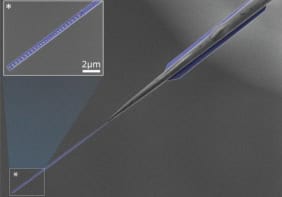Depositing extremely thin crystalline layers of different materials on a substrate – a process known as “epitaxy” – is key to the manufacture of semiconductor devices. But physicists have long been puzzled as to why some materials form flat ordered layers, whereas others grow as rough mound-like structures. Although researchers have created models of epitaxy that have helped the microelectronics industry, it has proved impossible to see how individual atoms move from site to site along a surface while forming a layer because the atoms are so small and move so fast.
Now, however, Itai Cohen and colleagues at Cornell University in the US have gained key insights into epitaxy by creating crystalline layers made of “colloidal” particles, which are bigger than atoms and so move much more slowly. They did this by bonding a closely packed layer of plastic balls 1 µm in diameter onto a flat substrate, which was then submerged in an aqueous solution of the balls. These balls were free to sediment onto the crystalline surface, where they slowly formed a thin layer.
In order to simulate the attractive interaction that causes atoms to crystallize into layers, the team then added much smaller polymer chains to the mixture, which coil up into spheres with a diameter of about 100 nm. Both the polymer spheres and the larger plastic balls are jostled about by random thermal fluctuations in the water (Brownian motion). But when two plastic balls come to within about 100 nm of each other, the polymer chains can no longer fit between them. Because there are no polymers between the balls to push them apart, the balls start to close in on each other – an imbalance that looks like a short-range attractive force.
Balls in motion
The team took a series of optical micrographs of the surface over several days, combining them to create a “movie” that shows how the plastic balls move (see above). The data reveal that when individual spheres land on the surface they move around randomly. But if the spheres get close to each other, they can coalesce to form a crystalline “island” that can grow by attracting other spheres.
In an ideal world, these islands would grow to cover the entire substrate, while remaining just one sphere thick. In practice, however, spheres tend to land on top of an existing island – and if these spheres cannot move over the edge of the island and onto the substrate, then the island will turn into a mound. Understanding and controlling the processes that cause such “step-edge barriers” are crucial to developing techniques for creating perfectly flat films.
As the interaction between atoms can extend out several atomic radii, atoms at an edge of a mound end up feeling an overall inward pull that keeps them on the island. However, the bonds between the plastic balls in the Cornell team’s model system are much shorter (relative to the ball’s radius) and the physicists did not expect to see such a barrier. But they did, which inspired the team to study the barrier using optical tweezers to place a sphere near a step edge and watching what happened next.
The Cornell team worked out that a sphere travelling across a step edge to the nearest lattice site has to move three times further than a sphere moving to a neighbouring site in any other direction. Because the motion of the spheres is described by a random walk, travelling over a step edge can take up to nine times longer than moving in another direction – which means that a sphere is more likely to remain on an island than leave it.
Cohen told physicsworld.com that such diffusion-related effects have not, as far as he is aware, ever been considered in models of atomic epitaxy, but they could be relevant because atoms are jostled about on a substrate by lattice vibrations. As a result, atoms could be “doubly cursed” when it comes to processes that work against the formation of perfectly flat films.
Biasing a random walk
On a more positive note, Cohen says that films of both spheres and atoms could be smoothed out by biasing the direction of diffusion. In the case of the spheres, this could be done by simply increasing the density mismatch between the particles and the fluid and letting gravity do the job. It may be possible to do the same for atoms by applying electric fields.
Other phenomena that could be studied using the spheres include surface reconstruction – a distortion of the surface lattice that often occurs when the film and substrate are different materials. This could be simulated by using two different-sized spheres for the substrate and film – something that the team is now investigating.
Cohen also points out that crystals made of micron-sized spheres are interesting in their own right. Indeed, they can be made with lattice constants on par with optical wavelengths. This means that they could find uses as photonic crystals in optical telecommunication devices.
The work is reported in Science 327 445.



